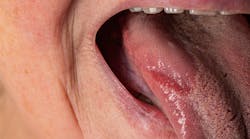Case study: Treating burning mouth syndrome with capsaicin
Many years ago, I went to lunch at a Thai restaurant with one of my close friends. I ordered my food “medium spicy,” but my friend wanted very spicy food. He didn’t want “American spicy”; he wanted “Thai spicy.”
A short while later, the waiter brought us our food. I enjoyed the pleasant heat from my medium-spicy Thai food. But as I looked across the table, I couldn’t help but notice my friend’s face was tomato red. He was sweating profusely, and his eyes were tearing.
“How’s your food?” I asked him.
“It’s great,” he stammered, not entirely convincingly.
A burning pain on the dorsal tongue
Let’s move to a different scenario. A patient reported to my office complaining of a burning pain on the dorsum of her tongue that had been there for a few years. I diagnosed her with burning mouth syndrome, a condition characterized by idiopathic, superficial burning pain most commonly perceived on the dorsal tongue.
I prescribed a rinse containing capsaicin as the active ingredient and instructed her to use it three times daily. When the patient returned a month later, she stated that her burning pain had decreased substantially.
What is the connection between these two stories?
How capsaicin works
Capsaicin is the compound that makes hot peppers hot. It is abundant in “Thai spicy” foods and in the rinse that I prescribed for my patient.
The technical details: Capsaicin in food gives us that familiar burning sensation by activating TRPV1 (transient receptor potential vanilloid 1), a receptor in our sensory nerves responsible for detecting thermal changes and other noxious sensory input. Once activated, the TRPV1 receptor causes the release of neuropeptides (such as substance P) that are involved with pain transmission.
If the TRPV1 receptor is repeatedly activated, the nerve cells eventually run out of substance P. The nerve becomes less capable of sending noxious impulses to the brain.
So, why couldn’t an American comfortably handle “Thai spicy” food? Surely, people from Thailand don’t sweat and stammer and suffer through every one of their meals. The secret is that if people consistently eat spicy food, they deplete their store of substance P and “burn out” their TRPV1 receptors. Now, spicy foods are more tolerable.
Why does capsaicin reduce symptoms of burning mouth syndrome?
What about my patient with burning mouth syndrome? Topical application of capsaicin works because it depletes the patient’s reserve of substance P from the nerves in the mouth. While application of capsaicin is very uncomfortable initially, repeated application leads to depletion of substance P and “burns out” the TRPV1 receptors. This leads to a reduction in symptoms. Several studies support the efficacy of topical capsaicin in the treatment of burning mouth syndrome.1,2
Capsaicin is a low-risk but potentially very effective method of managing burning mouth syndrome. Despite this, many patients are unable to tolerate or unwilling to trial capsaicin.
Fortunately, several other treatments for their condition may be offered that include topical medications (such as clonazepam rinse), oral medications (such as nortriptyline), and counseling interventions (such as cognitive behavioral therapy for pain).
Conclusion
If you have a patient who you suspect is suffering from burning mouth syndrome, consider prescribing topical capsaicin or referring the patient to an orofacial pain specialist.
Editor’s note: This article originally appeared in Perio-Implant Advisory, a chairside resource for dentists and hygienists that focuses on periodontal- and implant-related issues. Read more articles and subscribe to the newsletter.
References
- Silvestre FJ, Silvestre-Rangil J, Tamarit-Santafé C, Bautista D. Application of a capsaicin rinse in the treatment of burning mouth syndrome. Med Oral Patol Oral Cir Bucal. 2012;17(1):e1-e4. doi:10.4317/medoral.17219
- Bender SD. Burning mouth syndrome. Dent Clin North Am. 2018;62(4):585-596. doi:10.1016/j.cden.2018.05.006
About the Author

John E. Dinan, DMD, MS
John E. Dinan, DMD, MS, is a board-certified orofacial pain specialist who treats TMJ conditions and other orofacial pain. A 10-year veteran of the US Air Force, he completed his orofacial pain training at Walter Reed National Military Medical Center. He is a diplomate of the American Board of Dental Sleep Medicine and an expert at providing dental devices for the treatment of snoring and sleep apnea. Dr. Dinan practices in New York City, New York, and Springfield, New Jersey.

